Philippine Coast Guard
The Philippine Coast Guard (PCG) (Filipino: Tanod Baybayin ng Pilipinas) is an armed and uniformed service tasked primarily with enforcing laws within Philippine waters, conducting maritime security operations, safeguarding life and property at sea, and protecting marine environment and resources; similar to coast guards around the world. The Coast Guard also serves as an attached service of the Armed Forces of the Philippines in wartime.
| Philippine Coast Guard Tanod Baybayin ng Pilipinas | |
|---|---|
.svg.png.webp) Official Seal | |
 Racing Stripe | |
 Flag | |
| Abbreviation | PCG |
| Agency overview | |
| Formed | October 10, 1967 |
| Employees | 17,000 personnel [1] |
| Annual budget | ₱13.209 billion (US$274.8 million) (2021)[2] |
| Jurisdictional structure | |
| Operations jurisdiction | Philippines |
| Legal jurisdiction | Filipino Maritime Zone, International Waters |
| Primary governing body | Government of the Philippines |
| Secondary governing body | Department of Transportation (Philippines) |
| Constituting instrument |
|
| Specialist jurisdiction |
|
| Operational structure | |
| Headquarters | National Headquarters Philippine Coast Guard ,Port Area, Manila, Philippines |
| Agency executives | |
| Parent agency | Department of Transportation (2016-present) Department of Transportation and Communications (1998-2016) Department of National Defense (1967-1998) Department of Commerce and Police (1901-1913) |
| Facilities | |
| Patrol Vessels | 62 |
| Support Ships | 4 |
| Auxiliary Boats | 469 |
| Aircraft | Britten-Norman Islander |
| Helicopters | |
| Notables | |
| Significant operation | |
| Website | |
| coastguard | |
| Official Website | |

It is an agency attached to the Department of Transportation of the Philippines. It currently maintains a presence throughout the archipelago, with thirteen Coast Guard Districts, fifty-four CG Stations and over one hundred ninety Coast Guard Sub-Stations, from Basco, Batanes to Bongao, Tawi-Tawi.[3]
History
The Philippine Coast Guard is the oldest and only humanitarian armed service in the Philippines. Its beginnings could be traced back to the early 20th century when coast guarding was related to the protection of the customs services of the country and in patrolling the coastlines and harbors.
When the Americans came in 1898, one of the first steps that the military government undertook was the reopening of the port and customs facilities of Manila. Soon after, the civilian Insular Government, through the Philippine Commission, enacted a law on October 17, 1901 that created the Bureau of Coast Guard and Transportation, which was placed under the Department of Commerce and Police. The Captain of the Port was designated as Bureau Director.[4]
Recognition of the difficulty of administering such a vast island area without reliable government transportation resulted in the requirements to establish a transportation system for government services. The resulting report recommended purchase of 21 small steamers to establish 21 circuits supporting communication between provincial capitals and coastal towns as well as prevent smuggling and landing contraband. The average circuit would be . 651 mi (566 nmi; 1,048 km). The vessels required should be all weather of about 140 ft (42.7 m) in length capable of 10 kn (12 mph; 19 km/h) with light armament. Two small stern paddle steamers were recommended for river use on the Cayagen River and the Rio Grande de Mindanao and connected lakes.[5] The bureau concentrated its early days on the contracts for the fifteen vessels with the result ten were to be built by Farnham, Boyd & Company in Shanghai, China and five by Uraga Dock Company in Uraga, Japan.[4][6]
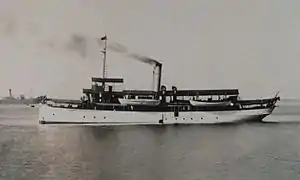
The ten Chinese contracted cutters were Balabac, Basilan, Busuanga, Corregidor, Luzon, Masbate, Negros, Palawan, Polillo, and Tablas. The five Uraga cutters were to be Marinduque and Romblon, which were delivered, and Bohol, Cebu, and Jolo which were cancelled after serious deficiencies were found on delivery of Marinduque and Romblon. The China built cutters began arriving in Manila by mid 1902 and were found to generally meet requirements. The Uraga built cutters, arriving in January and April 1903, had serious defects, to the extent the inspector in Japan was dismissed for negligence, and costly negotiations led to cancellation of the three others that were in process of completion. Five additional cutters were ordered from China, those being Leyte, Mindanao, Mindoro, Panay, and Samar.[6]
The lighthouse service was placed under the Bureau. In 1902, the Coast Guard fleet of 15 steamers from China and Japan was established and were assigned for the lighthouse service inspection trips of top government officials, for transport to Culion Island, for patrolling against illegal entry of aliens, and for troop movement of the Philippine Constabulary.
The Bureau of Coast Guard and Transportation was abolished on October 26, 1905 and the Bureau of Navigation took over its functions. The Bureau of Navigation was authorized to create a commissioned and enlisted service, and to adopt its own manual of court martial patterned after the US Navy.
Subsequently, however, the Bureau was also abolished on December 19, 1913 and the organization and its functions were transferred to the Bureau of Customs and the Bureau of Public Works until the establishment of the Commonwealth Government. After gaining independence from the United States, the Philippine government ceded some of the coast guard functions, such as the revenue cutter and lighthouse services, to the Philippine Naval Patrol, which eventually became the Philippine Navy. A Coast Guard unit was activated within the Philippine Navy to implement these functions.
On August 6, 1967, the Philippine Congress enacted Republic Act 5173 of the Philippine Coast Guard Law, which made the PCG a major unit of the Philippine Navy under a flag officer. The PCG was activated on October 10, 1967 and its coast guard functions were transferred from the navy.
The civilian nature of the PCG functions led to the separation of the Coast Guard from the Philippine Navy on March 30, 1998 by virtue of Executive Order 475 signed by President Fidel Ramos. It order effectively transferred the PCG from the Department of National Defense to the Office of the President, and eventually to the Department of Transportation and Communications (DOTC) on April 15, 1998 by virtue of Executive Order 477.
These executive orders provided inter alia that the PCG shall continue to the agency primarily responsible for the promotion of safety of life and property at sea and the protection of the maritime environment as mandated under the Philippine Coast Guard Law and Presidential Decrees 600, 601, 602, and 979, as a mended.
The transformation of the PCG into a non-military organization has a tremendous impact and significance. Its civilian character has allowed it to receive offers of vessels, equipment, technology, services, cooperation and other needed assistance from other countries, something which would not be readily offered to a military agency.
With enactment of Republic Act 9993, also known as the Coast Guard Law of 2009, as well as its implementing rules and regulations, the PCG has been vested with the necessary authority and responsibility to perform preventive measures in ensuring the safety of merchant vessels. The new law also strengthened PCG's authority to meet new challenges and increasing demands for marine resources, technological advancement and climate change. Further, the law has defined the PCG's rightful niche in the bureaucracy as the premier maritime agency and its vital role in nation building.
Organization
The Philippine Coast Guard is led by the Commandant of the Philippine Coast Guard, and directly reports to the Secretary of Transportation in maritime law enforcement, and also reports to the Chief of the Navy in wartime. The commandant is assisted by the Deputy Commandant for Administration and the Deputy Commandant for Operations.
Leadership
- Commander-in-Chief: Pres. Rodrigo Roa Duterte
- Secretary of Transportation: Atty. Arthur P. Tugade
- Commandant, Philippine Coast Guard: Admiral George V. Ursabia Jr., PCG
- Deputy Commandant for Administration: Vice Admiral Lyndon F. Latorre, PCG
- Deputy Commandant for Operations: Vice Admiral Leopoldo V. Laroya, PCG
- Chief of Coast Guard Staff: Rear Admiral Rolando Lizor N. Punzalan Jr., PCG
Ranks
Commissioned Officer Ranks
- Admiral (ADM) – General
- Vice Admiral (VADM) – Lieutenant General
- Rear Admiral (RADM) – Major General
- Commodore (COMMO) – Brigadier General
- Captain (CAPT) – Colonel
- Commander (CDR) – Lieutenant Colonel
- Lieutenant Commander (LCDR) – Major
- Lieutenant (LT) – Captain
- Lieutenant Junior Grade (LTJG) – 1st Lieutenant
- Ensign (ENS) – 2nd Lieutenant
- Probationary Ensign (P/ENS) – Trainee Rank or awaiting for Commissionship/Probationary 2nd Lieutenant
Non Commissioned Officer/Enlisted Ranks –
- First Master Chief Petty Officer (FMCPO) – First Chief Master Sergeant
- Master Chief Petty Officer (MCPO) – Chief Master Sergeant
- Senior Chief Petty Officer (SCPO) – Senior Master Sergeant
- Chief Petty Officer (CPO) – Master Sergeant
- Petty Officer 1st Class (PO1) – Technical Sergeant
- Petty Officer 2nd Class (PO2) – Staff Sergeant
- Petty Officer 3rd Class (PO3) – Sergeant
- Seaman First Class (SN1) – Corporal
- Seaman Second Class (SN2) – Private First Class
- Apprentice Seaman (ASN) – Private
- Candidate Coast Guardsman (CCGM) – Candidate Soldier
Coast Guard Districts
- Coast Guard District Northeastern Luzon
- Coast Guard District Northwestern Luzon
- Coast Guard District National Capital Region – Central Luzon
- Coast Guard District Southern Tagalog
- Coast Guard District Palawan
- Coast Guard District Bicol
- Coast Guard District Eastern Visayas
- Coast Guard District Western Visayas
- Coast Guard District Central Visayas
- Coast Guard District Southern Visayas
- Coast Guard District Northern Mindanao
- Coast Guard District Southeastern Mindanao
- Coast Guard District Southwestern Mindanao
Units
The Philippine Coast Guard's functional command units include:
- The Maritime Security Command (MARSECOM)
- Marine Environmental Protection Command (MEPCOM)
- Maritime Safety Services Command (MSSC)
The PCG used to be with the Armed Forces of the Philippines under the Philippine Navy before it was transferred to the Department of Transportation. The PCG is considered the third armed and uniformed service of the country primarily tasked with enforcing all applicable laws within the Philippine waters, conducting maritime security operations, safeguarding of life and property at sea and protecting the marine environment and resources.
Due to the 2004 SuperFerry 14 bombing incident in 2004, the PCG activated the Task Force Sea Marshals a composite team from the PCG, AFP and Philippine National Police. These Sea Marshals ride on board the passenger ferries traveling to and from Manila and other ports, and maintain a security presence aboard these ferries.
Coast Guard Aviation Force
The Coast Guard Aviation Force (CGAF), then known as Coast Guard Air Group was formally activated on May 18, 1998 during the incumbency of Commodore Manuel I de Leon PCG as Commandant, Philippine Coast Guard. Accordingly, Commander Noel O Monte PCG was designated as its first Commander holding office at the former PADC Hangar Nr. 3, Domestic Airport Complex, Pasay City.
On January 22, 1999, after eight months of existence, PCGAG acquired its first aircraft, a BN Islander from the Philippine National Oil Company – Energy Development Corporation (PNOC – EDC). After six months of intensive inspection and rehabilitation, it was commissioned into Coast Guard service on June 26, 1999 as PCG–251. In June 1999, the first helicopter, a MBB BO-105CB was acquired from PADC and commissioned with the tail number PCG–1636. Another aircraft, a Cessna 421B "Golden Eagle" was acquired without cost from the Bureau of Soils and Water Management sometime in the early part of 2000. However, due to budgetary constraints, the aircraft rehabilitation is not yet completed to date. In the same year, another BN Islander with the tail number PCG–684 was acquired. It was commissioned and activated in June 2002 after it underwent rehabilitation. On March 30, 2001, the helm of the CGAG was transferred to Captain Lino H Dabi PCG. In search of a bigger home for its growing inventory, on November 21, 2002, with the support of Pantaleon Alvarez, the Secretary of Transportation and Communications, the Manila International Airport Authority allowed CGAG to occupy its present location. Extensive renovation work was undertaken to make the hangar suitable as the nerve center of all Coast Guard Air Operations. On March 28, 2003, the CGAG acquired another BO – 105C helicopter from PADC and was commissioned into the service as PCG – 163 during the Group's 5th Founding Anniversary.
With the intense need to have the capability to extract survivors from water, the said helicopter was fitted with a rescue hoist through the courtesy of the Japan International Cooperation Agency. Another significant milestone unfolded in the history of the group when PCG leadership was turned over to Vice Admiral Arthur Gosingan PCG. Through the endorsement of the CGOF Commander, Rear Admiral Damian Carlos PCG in recognizing the importance of the air unit in coast guard operations and their outstanding accomplishments granted the aviators their most aspired yearning of their careers by approving the group's position paper on the Command Pilot Rating. This enabled aviators to have an equal opportunity with officers that acquired a Command at a Sea Badge to assume positions of higher responsibilities in the Coast Guard hierarchy.
Coast Guard Special Operations Force
The Philippine Coast Guard's Special Operations Force (CGSOF) is the special forces unit of the Philippine Coast Guard, founded in 1972. The CGSOF performs underwater operations, domestic counter-terrorism and other law enforcement operations. Some of their notable deployments and accomplishments include the operations to the Laoag Air crash at Manila Bay, the aftermath of the 2004 SuperFerry 14 bombing bombing, the Search and Recovery operations to the ill-fated M/V Princess of the Stars incident,[7] and the Battle of Marawi.
Philippine Coast Guard Auxiliary
The Philippine Coast Guard Auxiliary is the civilian support group of the Philippine Coast Guard. Although a volunteer, civilian organization, the PCGA uses a military structure for organizational purposes. Like other volunteer sea rescue organizations around the world, it performs non-military and non-police activities in support of its national navy or coast guard. This endeavor includes search and rescue, environmental protection, disaster relief, community service, and marine safety.
The ranks of the Philippine Coast Guard Auxiliary follow those of the Philippine Coast Guard.[8]
Operation Brotherhood Montessori Center has a few officers that serve as Leadership Training teachers and CAT teachers from this Coast Guard branch.
Philippine Coast Guard Officers’ Basic Education and Training Center
Like Training and Doctrine Command (TRADOC)’s Officer Candidate Schools (OCS) of Philippine Army, Philippine Navy and Philippine Air Force, the Philippine Coast Guard also has Philippine Coast Guard Officers’ Basic Education and Training Center (PCGOBETC)[9] that serves as officer candidate school of PCG officer aspirants.[10][11] Officer Candidates taking the Coast Guard Officers’ Course (CGOC) become Probationary Ensigns (P/ENS) and after graduation, they will be commissioned as regular officers in the organization.
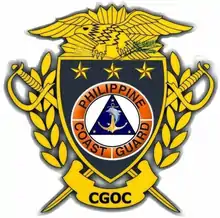
Ships in service
Major naval assets
| Class | Photo | Type | Ships | Origin | Note |
|---|---|---|---|---|---|
| Search and Rescue Vessels | |||||
| Gabriela Silang-class | .jpg.webp) | Offshore Patrol vessel | BRP Gabriela Silang | Built by French shipbuilder OCEA in Les Sables-d'Olonne, France. An 84-meter OPV (offshore patrol vessel) equipped with helipad. Delivered on December 18, 2019.[12] | |
| San Juan-class |  | Patrol vessel | BRP San Juan BRP EDSA II BRP Pampanga BRP Batangas | Built by Tenix. All 4 vessels that are 56 meters in length are in active service and equipped with helipad.[13] | |
| Parola-class |  | Patrol vessel | BRP Tubbataha BRP Malabrigo BRP Malapascua BRP Capones BRP Suluan BRP Sindangan BRP Cape San Agustin BRP Cabra BRP Bagacay BRP Cape Engaño | A new class of 44 meters 10 Multi-Role Response Vessels built by Japan Marine United. All 10 vessels in active service. | |
| Ilocos Norte-class |  | Patrol vessel | BRP Ilocos Norte BRP Nueva Vizcaya BRP Romblon BRP Davao del Norte | Built by Tenix. All 4 Vessels that are 35 meters in length are in active service. | |
| Support Ships | |||||
| Corregidor-class |  | Buoy tender | BRP Corregidor (AE-891) | Built by Niigata Engineering in Japan through a soft loan. Commissioned on February 3, 1998 and is currently in active service.[14] | |
| FS-type | Buoy tender | BRP Cape Bojeador (AE-46) | Built by Ingalls Shipbuilding. BRP Cape Bojeador is an ex-US Army FS 203 and ex-Philippine Navy TK 46. BRP Limasawa is an ex-USCG Nettle WAK 169, ex-US Army FS 397 and ex-Philippine Navy TK 69, and was retired from PCG service.[14] | ||
| Balsam-class | _underway_in_1949.jpg.webp) | Buoy tender | BRP Kalinga (AE-89) | Ex-USCG Balsam-class navigational aid tender, USCGC Redbud (WLB-398) built by Marine Iron and SB Corp. Refitted in Cavite Naval Yard in November 1995. Equipped with a helicopter platform and an ice-breaking bow.[14] | |
| Habagat-class |  | Medium-size ocean tugboat | BRP Habagat (TB-271) | ||
| Patrol Craft | |||||
| Boracay-class | .jpg.webp) | Fast Patrol Boat | BRP Boracay BRP Kalanggaman BRP Panglao BRP Malamawi | Built by French shipbuilder OCEA in Les Sables-d'Olonne, France. Four 24-meter FPB (fast patrol boat) 72 Mk. II for multi-role purposes. All four ships will be delivered in 2018. | |
| Swift Mk.1-class | Patrol craft | DF 300,[15] DF 301, DF 302,[16] DF 303[17] | |||
| Swift Mk.2-class | Patrol craft | DF 305, DF 307, DF 308,[18] DF-309, DF 310, DF 311, DF-312,[19] DF 313, DF-314,[20] DF-315, DF-316[21] | |||
| Swift Mk.3-class | Patrol craft | DF 325, DF 326, DF 327, DF 328, DF 329, DF 330, DF 331, DF 332, DF 334,[22] DF 347 | |||
| De Havilland 9209-class | Patrol craft | DF 318[23] | |||
| Coast Guard Cutter-type | patrol craft | CGC 30, CGC 32, CGC 103, CGC 110, CGC 115, CGC 128, CGC 129, CGC 130, CGC 132, CGC 133, CGC 134, CGC 135, CGC 136 | Transferred from the US Navy. Used for harbor police work. One was stricken in 1994, CGCs 30, 32 and 128 currently non-operational.[14] | ||
Minor naval assets
| Type | Photo | # of Ships | Origin | Note |
|---|---|---|---|---|
| 12-meter High Speed Interceptor Craft | 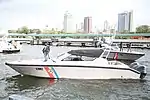 | 2 | 2 Yamaha High Speed Boat 1202 provided by Japan, to be used by Special Operations Group.[24] | |
| 10-meter Response Boat – Small |  | 4 | Acquired via US FMS Program. Additional units scheduled for delivery. | |
| Aluminum V-shaped hull boat |  | 320 | Used in search-and-rescue and disaster response. 300 ordered in an earlier contract, another 20 units delivered by Pacificfortia Marine Technologies in October 2018. | |
| Rigid-hulled inflatable boat | 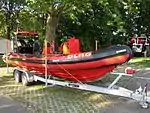 | 93 | From multiple suppliers | Used in search-and-rescue and disaster response. 81 units ordered earlier, another 12 units made by Trenton USA delivered in October 2018. |
| Rubber boat | 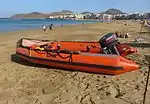 | 50 | From multiple suppliers | Used in search-and-rescue and disaster response |
Aircraft in service
| Aircraft | Photo | Origin | Type | Variant | In service | Notes |
|---|---|---|---|---|---|---|
| Fixed-wing Aircraft | ||||||
| BN-2 Islander | .jpg.webp) |
Search and Rescue | BN-2A | 2 | Tail number: PCG–684 and PCG-251. | |
| Helicopters | ||||||
| MBB Bo 105 | .jpg.webp) |
Search and Rescue | Bo 105C | 1 | 1 of 2 grounded.[25] | |
| Airbus H145 |  |
Search and Rescue | H145 | 2[26][27] | 5 more units planned to be acquired to complete the Maritime Disaster Response Helicopter Acquisition Project of the PH Coast Guard which requires 7 multirole helicopters.[26] | |
Recent acquisitions
Disaster Response Equipment for Philippine Coast Guard Project
The Project ensures that each of the Philippine Coast Guard's 12 Coast Guard District Headquarters will be assigned two Rubber Boats each for Rescue missions. Furthermore, all 63 Coast Guard Stations and the 237 Coast Guard Detachments will have one Aluminum Boat. Also, all 63 Coast Guard Stations will be equipped with one Rigid Hull Inflatable Boat (RHIB). Other RHIBs and Rubber Boats will be assigned to PCG Special Units and Search and Rescue vessels.
All the 300 Aluminum Boats, 81 RHIBs and 50 Rubber Boats will be equipped with 2 units VHF handheld marine-type Radio, 2 units Operators' Life Vests, 6 units of Common Life Vests, 1 Megaphone and 4 units of Flares.[28]
It is projected to minimize the instances when PCG personnel borrowing boats from fishermen, or other private entities to perform their duties during emergencies. This resulted in delays in the PCG's response time, making rescue operations less efficient.[29]
Under this same project but under a different public bidding document,[28] 15 units of M35 6×6 Trucks and 40 units rubber boats were purchased. 3 units of the trucks and all 40 rubber boat units are currently assigned with the National Headquarters of the PCG. The remaining 12 units of the M35 trucks are assigned to each of the 12 Coast Guard Districts. It is expected to further facilitate timely response to disaster situations.
Maritime Safety Capability Improvement Project (Phase I)
The Project aims to strengthen and further develop the coast watch/patrol and search and rescue capabilities of Philippine Coast Guard by procuring additional patrol vessels. This will support the PCG in fulfilling its mandate and in complying with the international commitments of the Philippines on maritime safety, security and environmental protection. The vessels are to be deployed in ten (10) PCG Districts Manila, Tacloban, Zamboanga, Puerto Princesa, La Union, Iloilo, San Fernando (La Union), Davao, Legaspi and Cagayan de Oro.[30]
This JICA Project supports PCG, who is responsible of Maritime Safety, to enhance its capabilities to quickly and appropriately respond to coastal maritime incidents, such as search and rescue, maritime law enforcement, etc., by providing Multi-Role Responsive Vessels (MRRVs), thereby increasing the vessel/maritime area rate of each of the 12 districts. The Project is also in line with development policy of the Philippines and assistance strategy of Japan. Therefore, it is relevant that JICA supports the implementation of the Project.[31]
During Japan's Minister of Foreign Affairs visit to Philippines in January 2013, Minister Fumio Kishida underscored the role of Japan as the Philippines' strategic ally. In the conference, he stressed Japan would provide 10 patrol vessels to the Philippine Coast Guard on a loan basis.[32][33] Shinzo Abe confirmed that 10 patrol boats will be swiftly donated to the Coast Guard.[34] President Aquino and Prime Minister Abe witnessed the signing of a $187-million (18.732 billion yen) loan for the Philippines’ acquisition of multi-role response vessels to boost the capability of its coast guard to conduct maritime patrols.[35]
Maritime Safety Capability Improvement Project for the Philippine Coast Guard (Phase II)
The project involves the acquisition of two (2) heavy weather, high endurance 94-meter Offshore Patrol Vessels (OPVs), to provide the PCG with vessels with a cruising range capability of 4,000 nautical miles, can be used in Sea-State 6 (wave height of up to 6 meters) in rough sea condition, and are capable to conduct continuous maritime patrol up to 15 days at 15 knots. Each vessel, as claimed by PCG, will enable them to recover as much as 500 passengers in the event of a maritime disaster, as well as provide the country with wider maritime coverage for strategic and national security purposes. Given these upgraded vessel capacities, the project now costs PhP8 billion and with the NEDA Board approval, are expected to be delivered by 2022.[36] [37]
Philippine Ports and Coast Guard Capability Development Project
The project aims to strengthen the Philippine Coast Guard's capability to promote safety of life, protect the marine environment and enforce maritime laws through procurement of four brand new 24-meter OCEA FPV 72MKII patrol boats and one 82-meter 270 MKII offshore patrol vessel.[38][39]
The budget from this project came from the loan balance of a French loan that financed the cancelled Greater Maritime Access Ports Project of the Arroyo administration.[40]
Maritime Disaster Response Helicopter Acquisition Project
The project involves the procurement of seven Maritime Disaster Response (MDR) helicopters for the Philippine Coast Guard to strengthen and expand their MDR capabilities during maritime incidents and natural disasters and calamities. The project will also involve the training of pilots and technical crew, procurement of mission equipment, procurement of maintenance tools and spare parts for five years, and the construction of hangars for the helicopters and offices for the pilots and technical crew.[41][42] It was supposed to be funded by the Credit Agricole of Germany.[43][44][45]
See also
References
Citations
- https://www.pna.gov.ph/articles/1104573
- "Marina, Coast Guard see lower 2020 budget, CAB gets more". PortCalls Asia. January 25, 2021. Retrieved January 31, 2021.
- "Mission – Pulse of the Maritime Environment · Philippine Coast Guard — News". Archived from the original on July 1, 2008. Retrieved June 30, 2008.
- "Bureau of Coast Guard and Transportation". Report of the Philippine Commission to the Secretary of War. Washington, D.C.: Government Printing Office: 243–244. 1902. Retrieved November 5, 2018.
- "Bureau of Coast Guard and Transportation". Report of the Philippine Commission to the Secretary of War. Washington, D.C.: Government Printing Office: 66–69. 1901. Retrieved November 5, 2018.
- "Bureau of Coast Guard and Transportation/Bureau of Vessels". Report of the Philippine Commission to the Secretary of War. Washington, D.C.: Government Printing Office: 12–15, 173–181. 1903. Retrieved November 5, 2018.
- Number of missing passengers rises. Retrieved on June 21, 2007.
- "Philippine Coast Guard Auxiliary Ranks". Philippine Coast Guard Auxiliary 609th Squadron. Retrieved April 27, 2017.
- http://www.congress.gov.ph/legisdocs/basic_18/HB04161.pdf
- "63 Coast Guard officer graduates 11-month training, new batch took oath". www.coastguard.gov.ph. Retrieved July 6, 2020.
- "Coast Guard Officer's Course Class 16-2015". www.coastguard.gov.ph. Retrieved July 6, 2020.
- "Gabriela Silang OPV Handed Over to Philippine Coast Guard by OCEA". philstar.com.
- "Status of the PCG Tenix boats". Timawa.net. Archived from the original on July 19, 2011. Retrieved January 7, 2011.
- "PCG Ships and Auxiliaries". Retrieved May 3, 2016.
- "DF-300 – Swift Mk.I class". defenseph.net.
- "DF-302 – Swift Mk.I". defenseph.net.
- "DF-303 – Swift Mk.1". defenseph.net.
- "DF-308 – Swift Mk.II". defenseph.net.
- "DF-312 – Swift Mk.II". defenseph.net.
- "DF-314 – Mk II design". defenseph.net.
- "DF-316". defenseph.net.
- "DF-334 - Swift Mk.III". defenseph.net.
- "DF-318 – Australian fiberglass-hulled". defenseph.net.
- "Tanod Baybayin". www.facebook.com.
- "Phl beefing up sea patrol assets". Philstar. Retrieved December 25, 2014.
- "Light to Medium Weight Multi-Purpose Twin Engine Helicopter Acquisition Projects of the Philippine Coast Guard". PH Defense Resource. Retrieved October 25, 2020.
- "Philippine Coast Guard becomes Philippines' first H145 operator for parapublic missions". Airbus. September 26, 2018. Retrieved November 16, 2018.
- "Disaster Response Equipment for Philippine Coast Guard Project" (PDF). Department of Transportation and Communications. July 10, 2012. Archived from the original (PDF) on April 2, 2015. Retrieved June 27, 2014.
- "DOTC, PCG allocates another Php152M in addition to the earlier PhP521M purchase of Disaster Response Equipment" (PDF). Department of Transportation and Communications. September 7, 2012. Retrieved July 8, 2014.
- "NEDA Official Development Assistance Projects' Status" (PDF). National Economic and Development Authority. March 1, 2010. Retrieved June 23, 2014.
- "Japan International Cooperation Agency (JICA)" (PDF). JICA. December 14, 2013. Retrieved June 23, 2014.
- "Acquisition of Multi-Role Response Vessels (MRRVs)". www.neda.gov.ph. November 30, 2012. Archived from the original on December 15, 2013. Retrieved November 30, 2012.
- "Budget for acquisition of Multi-Role Response Vessels (MRRVs)". www.timawa.net. November 29, 2012. Retrieved November 29, 2012.
- News, Kyodo. "Japanese PM confirms 10 ships for Philippine coast guard".
- "JICA and GOP sign agreement for ODA on maritime safety". Japan International Cooperation Agency. December 14, 2013. Retrieved July 2, 2014.
- "Acquisition of Two Large Multi-Role Response Vessels (MRRVs)". www.neda.gov.ph. September 14, 2016. Retrieved January 25, 2017.
 This article incorporates text from this source, which is in the public domain.
This article incorporates text from this source, which is in the public domain. - https://www.pna.gov.ph/articles/1093239
- "NEDA BOARD APPROVES SIX PROJECTS ON INFRASTRUCTURE, EDUCATION & AGRICULTURE". www.neda.gov.ph. June 27, 2013. Retrieved July 3, 2014.
- "NEDA board approves 6 projects on infrastructure, education, and agriculture". Philippine Official Gazette. June 27, 2013. Retrieved July 3, 2014.
- "Calendar Year 2012 ODA Portfolio Review" (PDF). www.neda.gov.ph. April 8, 2013. Retrieved July 3, 2014.
- "Archived copy" (PDF). Archived from the original (PDF) on February 13, 2014. Retrieved June 23, 2014.CS1 maint: archived copy as title (link)
- "Philippine National Transport Plan Executive Summary". Department of Transportation and Communications. March 12, 2010. Retrieved June 23, 2014.
- "Table" (PDF). www.dbm.gov.ph. 2014. Retrieved September 26, 2019.
- "Table" (PDF). www.dbm.gov.ph. 2013. Retrieved September 26, 2019.
- "Table" (PDF). www.dbm.gov.ph. 2015. Retrieved September 26, 2019.
External links
- Official website
- History of the Philippine Coast Guard from Official website
- Department of Transportation and Communications
| Wikimedia Commons has media related to Philippine Coast Guard. |
.svg.png.webp)